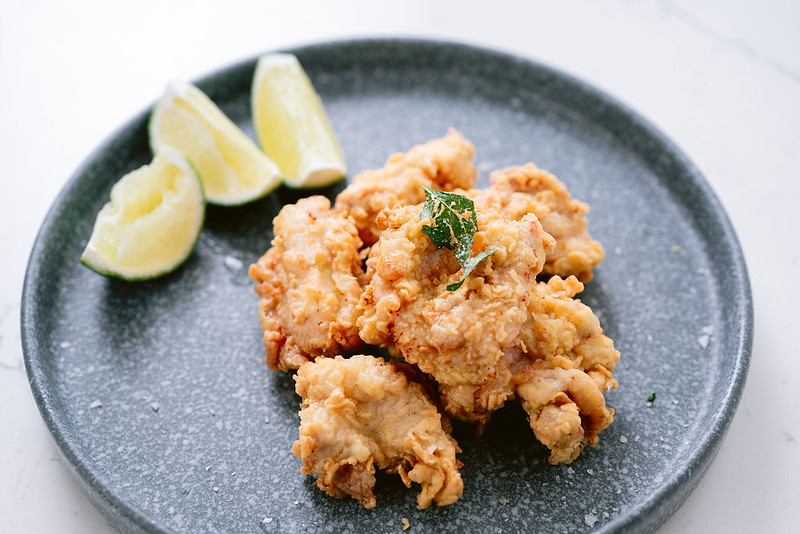Fried chicken has risen to menu stardom in recent years, with countless restaurants debuting their own takes on crispy wings, family-style platters or the chicken sandwich. Increasingly, chefs are adding bold flavors to make their fried chicken dishes stand out, a trend that is expected to keep growing. Sandwiches with spicy and sweet-heat fusion flavors are one of the top menu trend predictions for 2024, according to the What’s Hot Culinary Forecast from the National Restaurant Association, which calls the category “Fried chicken sandwiches 3.0.”
Culinary experts at the Worlds of Flavor International Conference and Festival hosted by the Culinary Institute of America in Napa, Calif., earlier this month discussed how their restaurants use fried chicken as a vehicle for introducing diners to flavors from around the globe.
Showcasing global flavors, cultures on US menus
At Wenwen in Brooklyn, N.Y., chef and co-owner Eric Sze created a Taiwanese-inspired take on fried chicken that has generated online buzz and lines of diners waiting to try the dish. Sze first began testing the recipe at his other New York City restaurant, 886, to showcase the yellow fat chickens he was able to source from a local supplier. The dish, named BDSM chicken for the “brined, de-boned, soy milk” elements of the recipe, starts with de-boning the chickens – except for the wings – to allow the birds to cook evenly as they are fried whole. For the coating, Sze created a wet batter that combines soy milk, silken tofu and sweet potato starch, which he said is a typical starch used in Taiwanese fried chicken.
“These are the only three ingredients. We blend it vigorously in the Vitamix to create a bunch of air bubbles, eliminating the need for baking soda,” he said. “And then what we do is we marinate our chicken, we dry it very thoroughly so that as much of the wet batter can stay on and then we fry it, and then we re-dredge it and then we fry it again.”
The process creates a crisp coating that is reminiscent of Korean fried chicken, a dish that Sze holds in high esteem. “I’m very, very jealous of the Koreans. I think they have the best fried chicken in the world,” he said.
“Korean fried chicken, when done well, is just such a melody of texture that’s just impossibly crisp – shatteringly crisp. I wanted our fried chicken to be at that level, without replicating a one-to-one recipe of Korean fried chicken.”
Similar to Sze’s approach of combining Taiwanese and Korean inspirations, chef Sam Fore blends Sri Lankan flavors with Southern fried chicken traditions at Tuk Tuk Snack Shop in Lexington, Ky. Fore opened the brick-and-mortar restaurant in September after growing her business that began as a fried chicken pop-up operating out of a tent.

“I actually originally had a career in marketing and advertising, and decided that one day I was going to cook in a tent,” Fore said. “And all of a sudden I had a vehicle to tell people about my upbringing, and about what I love to do…When you look at fried chicken around the world, it becomes a vehicle for people to share flavors, share stories, share what makes our chicken ours.”
For Fore, the essential flavors of Sri Lankan cuisine that she wanted to showcase in her fried chicken include curry powder, curry leaf and lime. To help the flavors of her proprietary spice mixture permeate the chicken, Fore uses a classic Southern fried chicken technique: marinating in buttermilk. Her dredge also incorporates a taste of the South with sorghum flour, which she said binds to the chicken well and makes for a light and gluten-free coating when combined with rice flour. She finishes the freshly-fried chicken with salt flavored with lime zest and fresh curry leaves, a final flourish that helps set the chicken apart and serves as a way of drawing diners in with its bold flavor and simplicity.
“I’m using common ingredients that are a callback to my childhood, but trying to make them accessible to more diners, to more cooks,” she said. “People don’t really think ‘I can make curry leaf salt at home.’ It’s so easy. And it’s things like this that make people step out of their comfort zones to make more food. And that’s how food proliferates. It’s not just because I decided to put everything that I’ve got in a chicken curry into buttermilk one day, it’s because I wanted to make it accessible so that people could understand why we do it.”
Serving a “taste of Texas” around the world
While restaurants like Wenwen and Tuk Tuk Snack Shop are helping introduce US diners to global flavors through fried chicken, US-based fried chicken chains are adapting their menus to appeal to international audiences.
Eric Stein, head of international culinary at Atlanta-based Church’s Texas Chicken, discussed how the 75-year-old quickservice chain develops its international menus. About half of the company’s 1,500 restaurants are international, and the company is constantly testing products to find iterations that resonate with customers in each region.
“I say I bring the legendary taste of Texas to the world,” Stein said. “We work on both brand-led flavor profiles that taste of Texas as well as localized flavor profiles, finding that mix of what are the local flavors that are going to work.”
Thailand is the brand’s largest market in the Asia Pacific region, where it is branded simply as Texas Chicken. There are about 100 units in Thailand, and they boast the company’s most extensive menu. The Thailand menu features classic Texas flavors like barbecue sauce as well as sauces that have proven popular with Thai diners, such as spicy lobster sauce.
In addition to making sure flavor profiles are pleasing to local palates, Stein’s team also takes product names into consideration. A spicy chicken sandwich that was originally named the Texas Firecracker was renamed Fire Crunch for the Middle East market and will debut in some Asia Pacific markets as the Thai Fire Sandwich after testing showed customer confusion around the translation of the word “firecracker.”
“It uses the same sauce, it’s the same product, but it just has a different name to make it more acceptable,” Stein said.
Watch the session to hear more insights from Stein, Fore and Sze, and check out other Worlds of Flavor session recordings.
Recent related stories:
- It’s not too early to talk about winter flavor trends
- Are better burgers, desserts the key to more nutritious, sustainable eating?
- Paving the way for a more inclusive wine industry
_____________________________________
If you liked this article, sign up to receive one of SmartBrief’s Food & Beverage newsletters. They are among SmartBrief’s more than 250 industry-focused newsletters.
